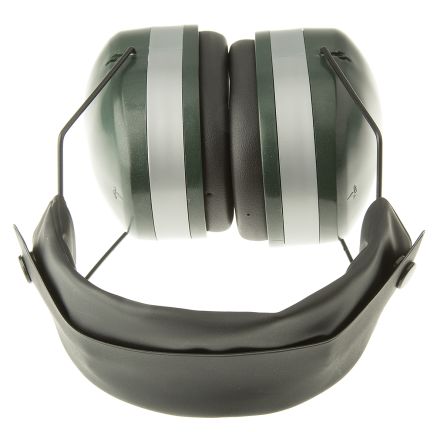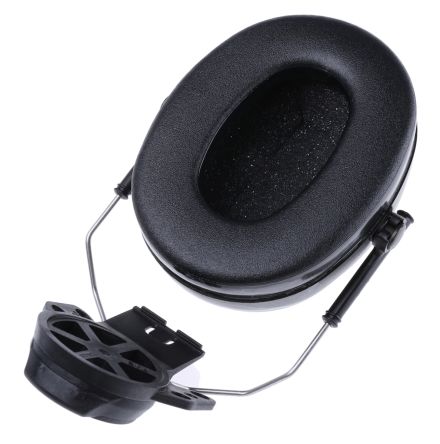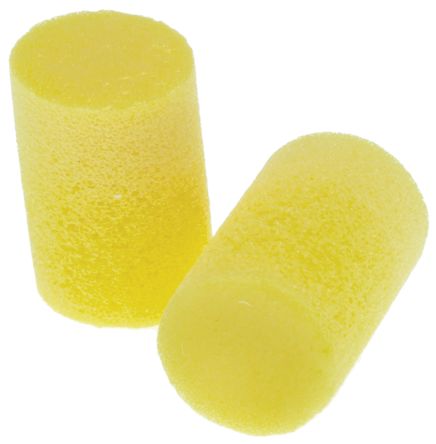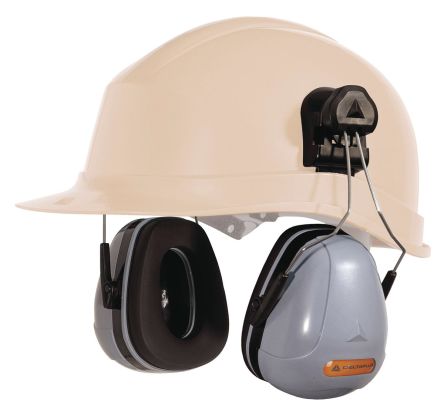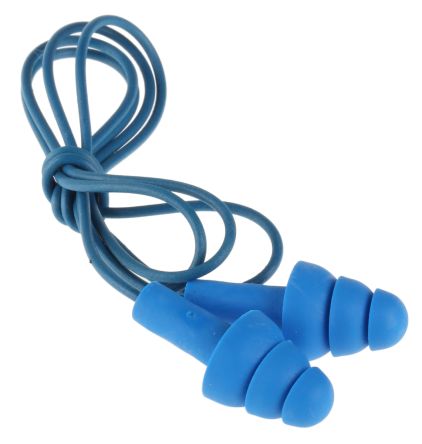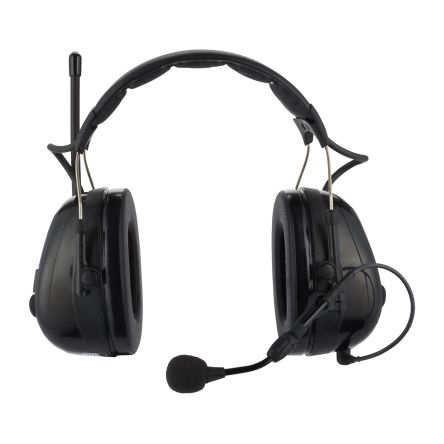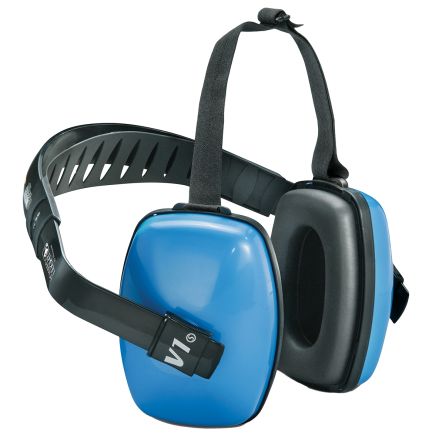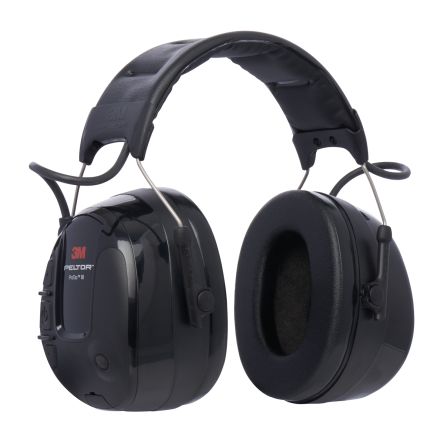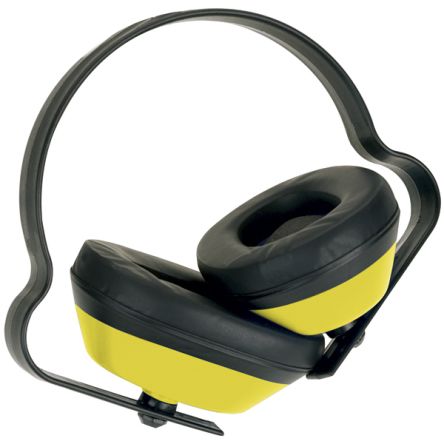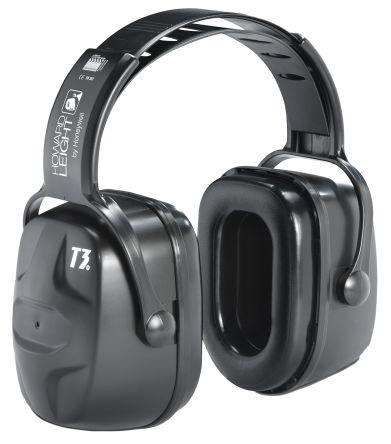
|
What are ear defenders?
Ear defenders, sometimes called ear muffs, are personal protective equipment (PPE) used to shield people from harsh noise levels.
They’re designed to protect ears from noise pollution by reducing the level of sound which reaches them. They have hard cups which fit over the ears, with soft cushions on the rims to comfortably grip them in place.
Some are designed to be secured with a headband and look like headphones, while others clip on the sides of a hard hat. Certain types have radio/music systems built in, as well as two-way communication.
By law, employers must eliminate or reduce the risk that employees face from exposure to loud noise, to help protect their hearing. Any protective equipment chosen by employers needs to reflect the level of risk to workers in that environment.
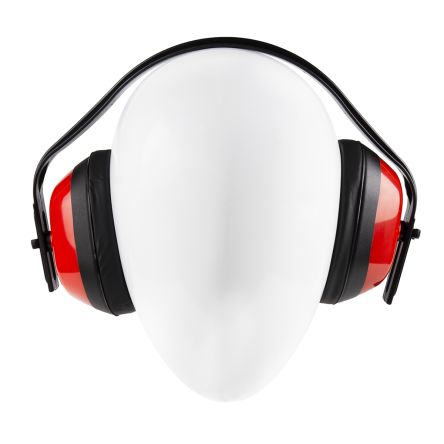
How do ear defenders work?
The protection is generally provided by acoustic foam, which absorbs sound waves by increasing air resistance. This then reduces the amplitude of the waves to prevent them from reaching the eardrum. The image below shows more information:
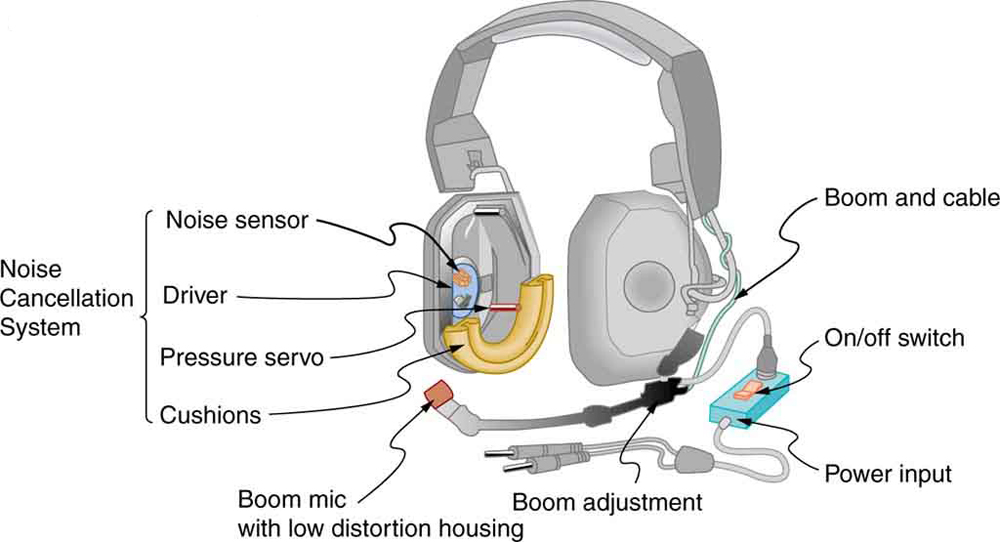
What are they made of?
The headband and outer covering of the earpiece are commonly made from a hard thermoplastic or metal. The padding on the ear defender itself is made from acoustic foam.
Maintenance
The pads on some types of ear defenders can be replaced, which increases their longevity.
Some manufacturers recommend changing the pads every six months, depending on the amount of use. To help make sure they’re providing the best protection, here are some tips and things to look out for:
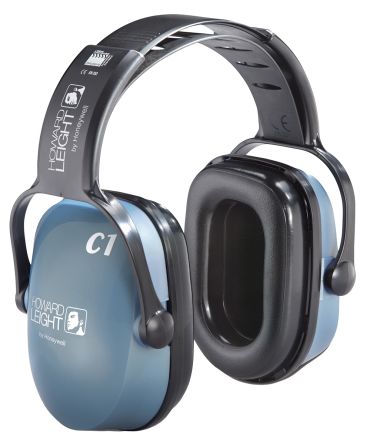
- Make sure the foam hasn’t become damaged or deformed, as this can impact the level of protection.
- Try to ensure the cushioning is always kept clean or replaced if needed.
- Check the outer earpiece and headband aren’t cracked or broken. If this happens, it should be completely replaced.
Replacement
To ensure they provide the necessary level of protection, here’s a guide on when they should be replaced:
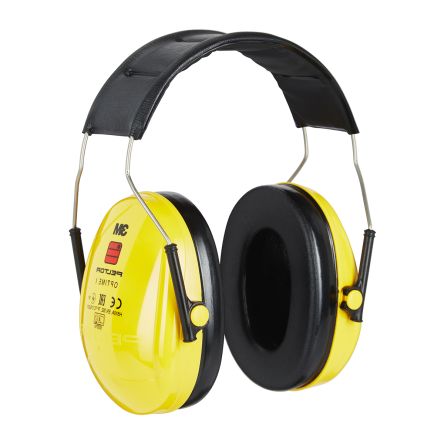
Headband models:
Helmet attachment models:
Disposable ear plugs:
- If they show wear and tear.
- If the headband becomes stretched.
- Every six to eight months for normal wear.
- Every three to four months with heavy use or in extreme/humid environments.
- If they show wear and tear.
- If the cushioning degrades.
- Every six to eight months for normal wear.
- Every three to four months with heavy use or in extreme/humid environments.
- Daily (or almost daily) to avoid bacteria and earwax build-up.
- Often they aren’t suitable for washing.
Different types of ear defenders
Headband
Helmet attachments
Earplugs
These are attached to a headband, which sits comfortably on the user’s head.
This design can be used if there isn’t the need for other protective clothing, such as a hard hat. Other types that fit alongside a helmet are available, to prevent compromising safety.
They’re also available with folding headbands, which can be carried around or stored more easily.
These can be worn alongside a hard hat and are very useful for tasks in the construction and mining industries, when other protective clothing is vital.
They simply clip straight on to the sides of a hard hat or helmet to work in conjunction with the headgear, rather than obstructing it.
Some designs can stay permanently clipped to the helmet, even when they’re not in use – so there’s no need to keep fixing and unfixing them.
As an alternative, earplugs are available to protect hearing in certain environments. There are two main types:
Disposable: These are usually soft and fit comfortably in your ear. Most commonly, they’re made of foam, mineral wadding or soft silicone.
Reusable: Reusable ones are made of soft plastic or rubber. They’re designed to be washed and used again, instead of discarded after one use.
Bluetooth
With microphone
Some models feature built-in Bluetooth technology. This is convenient and sometimes essential for certain tasks, as it allows the user to receive important calls.
Most modern Bluetooth models can be charged through the mini USB port, however, some still require batteries. This is something to bear in mind, as this can make them heavier.
One of the challenges with effective ear protection is that sometimes employees need to hear other people around them who might need to talk to them.
This type enables wearers to engage in two-way communication; so the wearer can listen to voices at a normal volume while still being protected from other noise.
With neckband
Electronic
With FM radio
Some headsets feature neckbands as well as headbands, which allow them to be worn alongside visors or helmets without affecting safety.
These are more advanced than the standard type; incorporating an electronic sound reproduction system.
These have a built-in FM radio so users can listen to music or entertainment.
How to choose hearing protection
Did you know? There are more than 17,000 people in the UK suffering from deafness, ringing in the ears or other conditions caused by noisy work environments.
The process of losing sound energy, which is called attenuation, can be amplified by wearing both earplugs and defenders at the same time. The attenuation data should be considered when choosing appropriate protection.
When choosing the best protection for a certain task or environment, it’s important to not just consider what noise reduction is needed, but also what sounds need to be kept in. It’s also important to ensure any hearing protection meets European safety standards.
Firstly, understand what level of sound needs to be reduced to figure out how many dB of protection is required. Most hearing protection has an eight-hour exposure rating.
Here’s a guide to the dB ranges for common noises in both work and everyday environments:
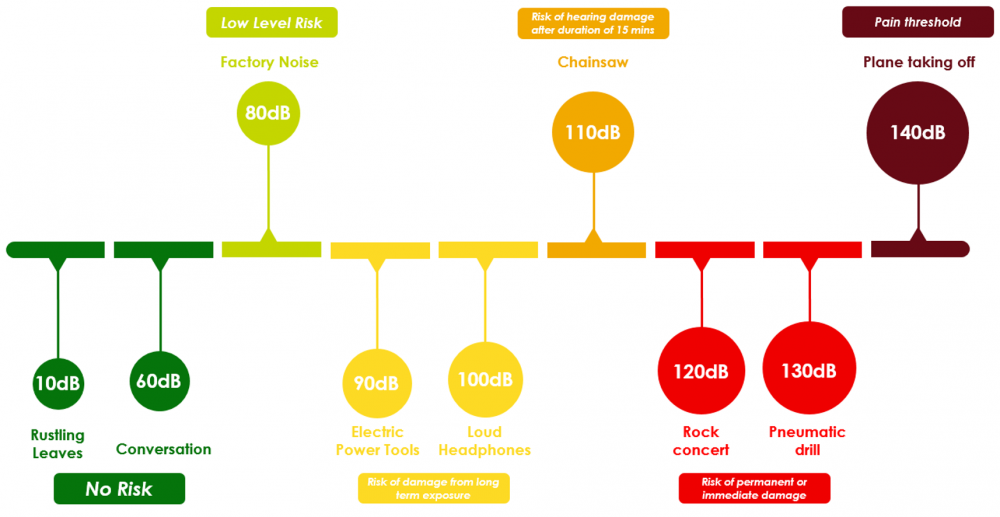
Top tip: If it’s sometimes difficult to hear what’s happening in the surrounding area, it might be tempting to take ear defenders off, but that poses a risk. To help, try to avoid ones which reduce the sound level reaching the ear to below 70 dB.
Other factors to consider
- Comfort - after working out the correct level of protection needed, the next thing is to make sure the headset is comfortable to wear, especially so users won’t be tempted to keep taking it off.
- Compatibility with other equipment - make sure it fits alongside other protective equipment, such as hard hats and visors. Hard hat versions slot on the outside of the helmet and some models feature neckbands. Be aware that hard hat models offer lower attenuation than headband versions.
What are ear defenders used for?
Here are some common tasks and environments which they’re used for:
Airport
Factory
Due to the sound produced by jet engines, runway workers need effective hearing protection.
In factories which use a lot of heavy machinery, it’s often mandatory to wear ear defenders.
Construction
Nightlife/event staff
Workers on noisy construction sites often need protection. While it won’t be necessary for everyone on the job, it’s often needed for workers doing certain tasks.
People working in places with loud music, such as nightclubs or live music venues, often need to wear protection. While not all employees have to, the ones who work closest to the speakers, such as security, will often have to wear earplugs.
How hearing can be damaged
Noise can cause damage to hair cells, membranes, nerves or other parts of the ear – leading to temporary or permanent hearing loss.
Did you know? The average person is born with roughly 16,000 hair cells within the cochlea.
Healthy human ears can generally hear sound frequencies ranging from 20Hz to 20,000Hz. But hearing loss occurs when sections of the nerves which carry sound information to the brain don’t work in the normal way. Noise-induced hearing loss (NIHL) is generally what occurs from exposure to sounds in the workplace.
Power tools, aeroplane engines or heavy traffic can cause damage to hair cells in the cochlea, which is how hearing can be damaged. This is because over time the hair cells get damaged or broken from sound vibrations, and when enough of them are damaged, loss of hearing occurs.
Sound is measured in decibels (dB). That’s because human ears can register sounds across a wide range of intensities, meaning a linear scale isn’t suitable for sound measurement.
To put this into a real-life context, a whisper is approximately 30 dB, a normal-volume conversation is around 60 dB, and a motorcycle engine is about 95 dB. By attending a live music concert, which is 105 to 110 dB, hearing loss can potentially occur in under five minutes. Therefore, employers must reduce sound levels to around 80 dB.
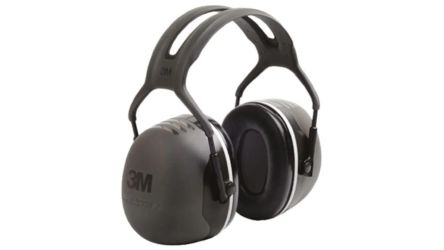
Why is wearing ear defenders important?
Hearing protection safeguards users from dangerously high noise levels, and many people aren’t aware of how devastating even common sounds such as a lawnmower can be.
While it’s not always possible to block out all dangerous sounds such as this, there are environments where appropriate care needs to be taken.
Harmful noise is one of the top three hazards in the workplace. In 2016, the Personal Protective Equipment Regulations officially recognised it as an irreversible health hazard.
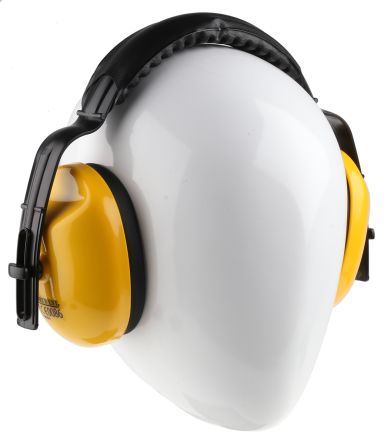
There are many ways to help noise reduction in the workplace, including silencers for loud machinery, but it’s impossible to eliminate all hazards. That’s why hearing protection is vital.
What’s more, the Personal Protective Equipment Directive adopted by the European Council in 1989 was superseded in April 2018 by a new PPE Regulation (EU) 2016/425. It comes into full force as of April 2019, meaning any new products on the market will have to comply with all aspects of the directive – so it’s worth investing in the correct protection.
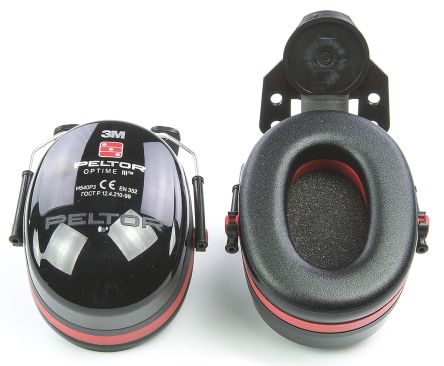
Hearing protection acts and legislation
The Control of Noise at Work Regulations 2005
This came into force for all industry sectors in the UK in April 2006, and for the music and entertainment sectors in April 2008.
It ensures that employers control sound levels in the working environment, or provide the correct safety equipment when employees are exposed to decibels higher than the norm.
The Safety, Health and Welfare at Work Act 2005
This regulation applies to all employers, employees (including fixed-term and temporary employees) and self-employed people in their workplaces.
It outlines that employers are legally required to ensure employees’ safety, health and welfare at work as far as is reasonably practicable. Under this, it states employers should provide protective clothing and equipment to employees.
Popular Brands
Please use the links below to view ear defenders sold by some of our most popular brands.
